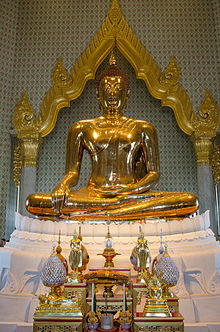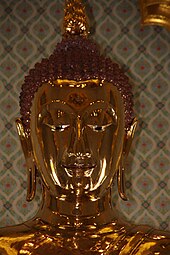วัดไตรมิตรวิทยาราม ถนนมิตรภาพไทย-จีนและถนนเจริญกรุง แขวงตลาดน้อย เขตสัมพันธวงศ์ กรุงเทพมหานคร.
Wat Suthat, Bangkok, Thailand.
Photo Gallery. Asian Historical Architecture.
ขอบคุณ ข้อมูลและภาพ จาก http://www.orientalarchitecture.com/sid/613/thailand/bangkok/wat-suthat
Wat Traimit (วัดไตรมิตรวิทยาราม) (19th c. buildings, 13th c. statue)
Wat Traimit from the outside is relatively plain, but it is of great interest and value because it houses the Golden Buddha, a solid gold image that weighs over five and a half tons (some suggest five tons). It is, as one might assume, the largest golden Buddha image in the world and is a most valued treasure of Thailand and of Buddhism.
The Golden Buddha was probably a product of the Sukhothai period in the 13th century that eventually was placed in an Ayutthaya temple. To camouflage it from Burmese invaders, it was given a thick plaster coating and was consequently "lost." The encased statue was moved to Bangkok and installed as the principal Buddha image in the main building of the Choti-naram Temple, or Wat Phrayakrai, during the reign of the third Chakri king, Rama III [Phra Nang Klao], (1824-51). The temple was deserted about 1931, and plaster-covered Buddha was moved to a temporary shelter in Wat Traimit. In the mid-1950's (some say 1955; others say 1957), as it was being moved to its permanent building, the rain soaked figure was dropped, and the stucco cracked to reveal the figure inside.
The Golden Buddha, in the mara conquering attitude, has a height of 15 feet 9 inches, including the base, from the base to the top of the crown. The statue alone is about 10 feet high. It is 12 feet 9 inches in diameter.
Location
The approximate location of the site is 13.737935' N, 100.513771' E (WGS 84 map datum).
01.Wat Suthat, Bangkok, Thailand. Photo Gallery. Asian Historical Architecture.
วัดไตรมิตรวิทยาราม ถนนมิตรภาพไทย-จีนและถนนเจริญกรุง แขวงตลาดน้อย เขตสัมพันธวงศ์ กรุงเทพมหานคร.
02.Wat Suthat, Bangkok, Thailand. Photo Gallery. Asian Historical Architecture.
วัดไตรมิตรวิทยาราม ถนนมิตรภาพไทย-จีนและถนนเจริญกรุง แขวงตลาดน้อย เขตสัมพันธวงศ์ กรุงเทพมหานคร.
03.Wat Suthat, Bangkok, Thailand. Photo Gallery. Asian Historical Architecture.
วัดไตรมิตรวิทยาราม ถนนมิตรภาพไทย-จีนและถนนเจริญกรุง แขวงตลาดน้อย เขตสัมพันธวงศ์ กรุงเทพมหานคร.
04.Wat Suthat, Bangkok, Thailand. Photo Gallery. Asian Historical Architecture.
วัดไตรมิตรวิทยาราม ถนนมิตรภาพไทย-จีนและถนนเจริญกรุง แขวงตลาดน้อย เขตสัมพันธวงศ์ กรุงเทพมหานคร.
05.Wat Suthat, Bangkok, Thailand. Photo Gallery. Asian Historical Architecture.
วัดไตรมิตรวิทยาราม ถนนมิตรภาพไทย-จีนและถนนเจริญกรุง แขวงตลาดน้อย เขตสัมพันธวงศ์ กรุงเทพมหานคร.
06.Wat Suthat, Bangkok, Thailand. Photo Gallery. Asian Historical Architecture.
วัดไตรมิตรวิทยาราม ถนนมิตรภาพไทย-จีนและถนนเจริญกรุง แขวงตลาดน้อย เขตสัมพันธวงศ์ กรุงเทพมหานคร.
07.Wat Suthat, Bangkok, Thailand. Photo Gallery. Asian Historical Architecture.
วัดไตรมิตรวิทยาราม ถนนมิตรภาพไทย-จีนและถนนเจริญกรุง แขวงตลาดน้อย เขตสัมพันธวงศ์ กรุงเทพมหานคร.
08.Wat Suthat, Bangkok, Thailand. Photo Gallery. Asian Historical Architecture.
วัดไตรมิตรวิทยาราม ถนนมิตรภาพไทย-จีนและถนนเจริญกรุง แขวงตลาดน้อย เขตสัมพันธวงศ์ กรุงเทพมหานคร.
09.Wat Suthat, Bangkok, Thailand. Photo Gallery. Asian Historical Architecture.
วัดไตรมิตรวิทยาราม ถนนมิตรภาพไทย-จีนและถนนเจริญกรุง แขวงตลาดน้อย เขตสัมพันธวงศ์ กรุงเทพมหานคร.
10.Wat Suthat, Bangkok, Thailand. Photo Gallery. Asian Historical Architecture.
วัดไตรมิตรวิทยาราม ถนนมิตรภาพไทย-จีนและถนนเจริญกรุง แขวงตลาดน้อย เขตสัมพันธวงศ์ กรุงเทพมหานคร.
11.Wat Suthat, Bangkok, Thailand. Photo Gallery. Asian Historical Architecture.
วัดไตรมิตรวิทยาราม ถนนมิตรภาพไทย-จีนและถนนเจริญกรุง แขวงตลาดน้อย เขตสัมพันธวงศ์ กรุงเทพมหานคร.
12.Wat Suthat, Bangkok, Thailand. Photo Gallery. Asian Historical Architecture.
วัดไตรมิตรวิทยาราม ถนนมิตรภาพไทย-จีนและถนนเจริญกรุง แขวงตลาดน้อย เขตสัมพันธวงศ์ กรุงเทพมหานคร.
13.Wat Suthat, Bangkok, Thailand. Photo Gallery. Asian Historical Architecture.
วัดไตรมิตรวิทยาราม ถนนมิตรภาพไทย-จีนและถนนเจริญกรุง แขวงตลาดน้อย เขตสัมพันธวงศ์ กรุงเทพมหานคร.
14.Wat Suthat, Bangkok, Thailand. Photo Gallery. Asian Historical Architecture.
วัดไตรมิตรวิทยาราม ถนนมิตรภาพไทย-จีนและถนนเจริญกรุง แขวงตลาดน้อย เขตสัมพันธวงศ์ กรุงเทพมหานคร.
15.Wat Suthat, Bangkok, Thailand. Photo Gallery. Asian Historical Architecture.
วัดไตรมิตรวิทยาราม ถนนมิตรภาพไทย-จีนและถนนเจริญกรุง แขวงตลาดน้อย เขตสัมพันธวงศ์ กรุงเทพมหานคร.
16.Wat Suthat, Bangkok, Thailand. Photo Gallery. Asian Historical Architecture.
วัดไตรมิตรวิทยาราม ถนนมิตรภาพไทย-จีนและถนนเจริญกรุง แขวงตลาดน้อย เขตสัมพันธวงศ์ กรุงเทพมหานคร.
17.Wat Suthat, Bangkok, Thailand. Photo Gallery. Asian Historical Architecture.
วัดไตรมิตรวิทยาราม ถนนมิตรภาพไทย-จีนและถนนเจริญกรุง แขวงตลาดน้อย เขตสัมพันธวงศ์ กรุงเทพมหานคร.
Wat Suthat, Bangkok, Thailand.
Photo Gallery. Asian Historical Architecture.
ขอบคุณ ข้อมูลและภาพ จาก http://www.orientalarchitecture.com/sid/613/thailand/bangkok/wat-suthat
-----------------------------------------------------------------------
ขอบคุณ ข้อมูลและภาพ จาก https://en.wikipedia.org/wiki/Golden_Buddha_(statue)
----------------------------------------------------------------------
ขอบคุณ ข้อมูลและภาพ จาก https://th.wikipedia.org/wiki/วัดไตรมิตรวิทยาราม
---------------------------------------------------------------------
--------------------------------------------------------------------
-----------------------------------------------------------------------
ขอบคุณ ข้อมูลและภาพ จาก https://en.wikipedia.org/wiki/Golden_Buddha_(statue)
Golden Buddha (statue)
From Wikipedia, the free encyclopedia
The Golden Buddha, officially titled Phra Phuttha Maha Suwana Patimakon (Thai: พระพุทธมหาสุวรรณปฏิมากร), is a goldstatue, with a weight of 5.5 tons (5,500 kilograms). It is located in the temple of Wat Traimit, Bangkok, Thailand.
Contents
[hide]History[edit]
The origins of this statue are uncertain. It is made in the Sukhothai Dynasty style of the 13th-14th centuries, though it could have been made after that time. The head of the statue is egg-shaped, which indicates its origin in the Sukothai period. Given that Sukothai art had Indian influences[1] and metal figures of the Buddha made in India used to be taken to various countries for installation, this suggests the Golden Buddha statue may have been cast in parts in India.[2]
Some scholars believe the statue is mentioned in the somewhat controversial Ram Khamhaeng stele. In lines 23-27 of the first stone slab of the stele, "a gold Buddha image" is mentioned as being located "in the middle of Sukhothai City," interpreted as being a reference to the Wat Traimit Golden Buddha.[4]
At some point, the statue was completely plastered over to prevent it from being stolen. The statue was covered with a thick layer of stucco, which was painted and inlaid with bits of coloured glass.[1] It is believed that this plastering over took place before the destruction of Ayutthaya kingdom by Burmese invaders in 1767. The statue remained among the ruins of Ayutthaya without attracting much attention.
In 1801, Thai King Buddha Yodfa Chulaloke (Rama I), after establishing Bangkok as a new capital city of the Kingdom, and after commissioning the construction of many temples in Bangkok, ordered that various old Buddha images should be brought to Bangkok from the ruined temples around the country.[3]
At the time of King Rama III (1824-1851), the statue, still covered with stucco, was installed as the principal Buddha image in the main temple building of Wat Chotanaram in Bangkok.[5]
When Wat Chotanaram, located near Chinatown, fell into disrepair and was closed, the statue was moved to its present location at the nearby Wat Traimit in 1935.[4] At the time, Wat Traimit was a pagoda of minor significance (like hundreds of other Buddhist temples that exist in Bangkok). Since the temple didn't have a building big enough to house the statue, it was kept for 20 years under a simple tin roof. The true identity of this statue had been forgotten for almost 200 years.[6]
Discovery of the golden statue[edit]
In 1954, a new Viharn building was built at the temple to house the statue. It was being moved to its new location on 25 May 1955 and there are a variety of accounts of what exactly happened next, but it is clear that during the final attempt to lift the statue from its pedestal, the ropes broke, and the statue fell hard on the ground. At that moment, some of the plaster coating chipped off, allowing the gold surface underneath to be seen. Work was immediately stopped so that an evaluation could be made.[3]
All the plaster was carefully removed and during the process, photos were taken, and are now displayed in the Temple for visitors. Pieces of the actual plaster are also on public display. When all the plaster was removed, it was found that the gold statue actually consisted of nine parts that fit smoothly together. A key was also found encased in plaster at its base, which can be used to disassemble the statue, allowing for easier transportation.[4]
The golden statue was discovered very close to the commemoration of the twenty-fifth Buddhist Era (2500 years since Gautama Buddha's passing) so the Thai news media was full of reports and many Buddhists regarded the occurrence as miraculous.[3]
On 14 February 2010, a large new building was inaugurated at the Wat Traimit Temple to house the Gold Buddha. The building also contains the Bangkok Chinatown Heritage Centre, and an exhibition on the origin of the Gold Buddha.[7]
Characteristics[edit]
The statue is 3 metres (9.8 ft) tall and weighs 5.5 tonnes (5.4 long tons; 6.1 short tons). (According to another account, the statue measures 3.91 meters from base to top, and 3.10 meters across the lap from knee to knee.) It can be disassembled into nine pieces.[7] The statue was housed in a wat in Ayutthaya until the mid 19th century, and its provenance from Ayutthaya excludes the possibility of it having been made after about 1750.
At US$1,400 per troy ounce, the gold in the statue (18 karat) is estimated to be worth 250 million dollars.[8] The body of the statue is 40% pure, the volume from the chin to the forehead is 80% pure, and the hair and the topknot, weighing 45 kg, are 99% pure gold.[7]
The Buddha is represented in the traditional pose of Bhumisparsha Mudra (touching the earth with the right hand to witness Shakyamuni Buddha's enlightenment at Bodh Gaya). The original statues of Sukhothai sit on a common pedestal form. The flame that crowns the ushnisha is an innovation of Sukhothai that symbolises the splendour of spiritual energy. The line of the hairdressing forms a "V" shape in the root of the hairs, underlined by the elegant curve of the eyebrows that join above the aquiline nose, all according to the prescribed rules. The three wrinkles in the neck and the much elongated ear lobes, signs of his former status of prince, also form part of the code, as do the wide shoulders and the chest inflated.
ขอบคุณ ข้อมูลและภาพ จาก https://th.wikipedia.org/wiki/วัดไตรมิตรวิทยาราม
วัดไตรมิตรวิทยารามวรวิหาร
จากวิกิพีเดีย สารานุกรมเสรี
บทความนี้เกี่ยวกับวัดที่มีชื่อเสียงในกรุงเทพมหานครและประเทศไทย สำหรับความหมายอื่น ดูที่ ไตรมิตร (แก้ความกำกวม)
| วัดไตรมิตรวิทยารามวรวิหาร | |
|---|---|

วัดไตรมิตรวิทยารามวรวิหาร
| |
| ข้อมูลทั่วไป | |
| ชื่อ | วัดไตรมิตร, วัดสามจีน |
| ที่ตั้ง | ถนนมิตรภาพไทย-จีนและถนนเจริญกรุง แขวงตลาดน้อย เขตสัมพันธวงศ์ กรุงเทพมหานคร 10100 |
| ประเภท | พระอารามหลวงชั้นโท ชนิดวรวิหาร |
| นิกาย | เถรวาท |
| พระประธาน | พระพุทธทศพลญาณ |
| พระพุทธรูปสำคัญ | พระพุทธมหาสุวรรณปฏิมากร |
| ในพระมหามณฑปชั้น 4 ประดิษฐานพระพุทธมหาสุวรรณปฏิมากร | |
| จุดสนใจ | ชั้น 2 ชมนิทรรศการศูนย์ประวัติศาสตร์เยาวราช ชั้น 3 ชมนิทรรศการที่เกี่ยวกับพระพุทธมหาสุวรรณปฏิมากร |
| เว็บไซต์ | wattraimitr-withayaram.com |
วัดไตรมิตรวิทยาราม ตั้งอยู่ที่ถนนมิตรภาพไทย-จีน แขวงตลาดน้อย เขตสัมพันธวงศ์ เป็นวัดโบราณอยู่ในที่ลุ่มพระอารามเป็นเรือนไม้ มีชื่อเดิมว่า "วัดสามจีน" เข้าใจกันว่า ชาวจีน 3 คนร่วมกันสร้างพระอารามเพื่อเป็นวิหารทานการบุญ [มีความตำนานใกล้เคียงกับวัดนางปลื้ม (วัดสามปลื้ม) หรือวัดจักรวรรดิฯ ทำนองเดียวกัน]
ในปีพุทธศักราช 2477 พระมหากิ๊ม สุวรรณชาต ผู้รักษาการในหน้าที่เจ้าอาวาสเป็นผู้ริเริ่มปรับปรุงวัด ต่อมาในปีพุทธศักราช 2480 ได้รับอนุมัติจากมหาเถรสมาคมให้ปรับปรุงสภาพวัดให้ดีขึ้น ปีพุทธศักราช 2482 พ่อค้าประชาชน คณะครูและนักเรียน ได้ร่วมกันปฏิสังขรณ์และเปลี่ยนนามใหม่ เป็นชื่อ วัดไตรมิตรวิทยาราม ซึ่งมีความหมายว่า เพื่อน 3 คนร่วมกันสร้างวัดนี้ ประกอบกับวัดเป็นที่ตั้งโรงเรียนปริยัติธรรมและโรงเรียนไตรมิตรวิทยาลัยของรัฐบาลอยู่ภายในบริเวณของวัด
ปูชนียวัตถุ[แก้]
พระพุทธทศพลญาณ[แก้]
พระพุทธทศพลญาณ พระประธานในพระอุโบสถ เป็นพระพุทธรูปปางมารวิชัย ปูนปั้น ลงรักปิดทอง ประชาชนทั่วไปเรียกว่า “หลวงพ่อโต” บ้าง “หลวงพ่อวัดสามจีน” มีประชาชนมาบนบานกันเสมอ ๆ ด้วยพวงมาลัยดอกมะลิ พระบาทสมเด็จพระจุลจอมเกล้าเจ้าอยู่หัวได้เคยทรงเสด็จพระราชดำเนินมานมัสการ และได้ตรัสยกย่องว่า เป็นพระพุทธรูปที่มีพระพุทธลักษณะงดงามยิ่งนัก “หลวงพ่อโม” อดีตเจ้าอาวาสวัดไตรมิตรวิทยาราม เคยได้ทำพระเครื่องแจกครั้งหนึ่ง ได้ทำเป็นรูปพระพุทธทศพลญาณสร้างด้วยเนื้อชิน เรียกชื่อว่า หลวงพ่อโตวัดสามจีน ปรากฏว่าเป็นที่นิยมนับถือของคนทั่งไปว่าศักดิ์สิทธินัก ปัจจุบันนี้หายากแล้ว
พระสุโขทัยไตรมิตร[แก้]
สิ่งสำคัญของวัด คือ พระสุโขทัยไตรมิตร เป็นพระพุทธรูปทองคำที่ใหญ่ที่สุดและได้รับการบันทึกในหนังสือบันทึกสถิติโลกกินเนสส์ พระพุทธรูปทองคำองค์นี้มีหน้าตั้งกว้าง 3.01 เมตร สูง 3.91 เมตร องค์พระสามารถถอดได้ 9 องค์ จากฐานองค์พระขึ้นไปเนื้อทองบริสุทธิ์ 40% พระพักตร์มีเนื้อทอง 80% ส่วนพระเกศมีน้ำหนัก 45 กิโลกรัม เป็นเนื้อทองบริสุทธิ์ 99.99%
สันนิษฐานว่าสร้างในสมัยสุโขทัย ปางมารวิชัย เข้าใจว่า เดิมประดิษฐานอยู่ที่วัดมหาธาตุ จังหวัดสุโขทัย ต่อมาในสมัยพระบาทสมเด็จพระพุทธยอดฟ้าจุฬาโลก ได้โปรดเกล้าฯ ให้กรมพระราชวังบวรมหาสุรสิงหนาท ไปอัญเชิญพระพุทธรูปมาจากเมืองเหนือเพื่อนำมาประดิษฐานยังวัดสำคัญ พระพุทธรูปที่เชิญมามีจำนวนมาก ทำให้ดูแลไม่ทั่วถึง ขุนนางผู้หนึ่งจึงแอบเอาปูนไล้พระพุทธรูปทองคำแล้วนำมาไว้ยังวัดที่ตนสร้าง จนได้อัญเชิญมาไว้ที่วัดพระยาไกร (วัดโชติการาม) ต่อมาบริษัท อี๊สต์เอเชียติ๊ก ได้ขอเช่าที่วัด (ซึ่งขณะนั้นเป็นวัดร้างแล้ว) เป็นโรงเลื่อยจักร จึงได้อัญเชิญไว้ที่ข้างพระเจดีย์และปลูกเพิงสังกะสีมุงเป็นหลังคากั้นไว้อย่างหยาบ ๆ หลังจากนั้นเป็นเวลาเกือบ 20 ปี เมื่อพระอุโบสถและพระวิหารหลังใหม่สร้างเสร็จจึงได้อัญเชิญขึ้นประดิษฐาน แต่ในระหว่างการเคลื่อนย้ายปูนที่หุ้มองค์พระกระเทาะออก จึงทำให้เห็นองค์พระข้างในเป็นทองคำ เมื่อวันที่ 25 พฤษภาคม พ.ศ. 2498
---------------------------------------------------------------------
--------------------------------------------------------------------






















ไม่มีความคิดเห็น:
แสดงความคิดเห็น